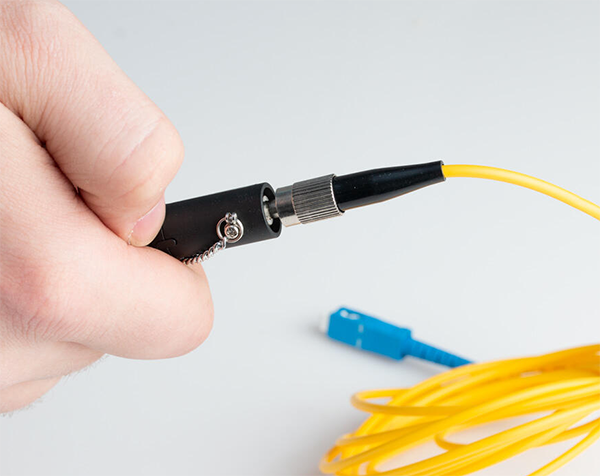

 Knowledge Base +
Knowledge Base +  2023.12.08
2023.12.08Finding a fiber fault typically involves the following steps:
1. Visual inspection: Visually inspect the fiber optic cable for any physical damage such as cuts, bends, or breaks. Use a fiber optic microscope to inspect the end faces of the connectors for any contamination or damage.
2. Use a light source and power meter: Connect a light source to one end of the fiber and a power meter to the other end. Check for any loss of signal or fluctuations in power levels, which can indicate a fault in the fiber.
3. OTDR testing: Use an Optical Time Domain Reflectometer (OTDR) to send a pulse of light down the fiber and analyze the reflections to locate the exact location of the fault, as well as the nature of the fault (such as a break, bend, or splice).
4. Continuity testing: Use a fiber optic continuity tester to check for breaks or opens in the fiber.
5. Breakout testing: If possible, break the fiber optic cable into smaller segments and test each segment individually to isolate the location of the fault.
6. Visual Fault Locator (VFL): Use a VFL to visually trace the fiber and locate any breaks or bends by emitting a visible light through the fiber.
By following these steps, you can identify and locate a fault in a fiber optic cable.
Fiber optic cables are an essential component of modern communication systems, delivering high-speed data transfer and reliable connectivity. However, fiber optic cables can develop faults due to a range of factors, such as improper installation, accidental damage, or wear and tear. Finding and fixing these faults can be challenging, especially when dealing with long cables or complex networks.
 - VFL-150_1_3_1702259381.jpg)
Fortunately, visual fault locators (VFLs) can help technicians quickly identify the location of faults in fiber optic cables. VFLs use a laser beam to generate visible light that travels through the cable, illuminating any breaks or faults in the fiber. One such visual fault locator, the Jonard Tools VFL-25, is the perfect tool for inspecting and troubleshooting fiber networks. It is designed for field personnel who need a portable light source for fiber tracing, fiber routing, and to locate breakpoints caused by bending or cracking in fiber optic cables and poor connections.

The VFL-25 Visual Fault Locator and the VFL-150 Fault Locator Kit (includes the VFL-25 Visual Fault Locator and the VFL-25125 FC to LC Adapter) are the go-to tools for examining fiber optic patch cords, ribbon or bunched pig tails. Visual fault locators are also commonly used for testing fiber optic networks, telecommunications and CATV fields. It is an indispensable tool in fiber cable network construction, fiber network maintenance and optical component manufacturing and research. The VFL-25 Class IIIa laser emits a red laser to inspect for fiber failure. It should be noted that visual fault locators generally are not suitable for work on dark or shielded cables.
Choose SFP or Advanced SFP+?
SFP and SFP+ are applied at different transmission speeds. SFP module supports 1Gb data rate, and the SFP type includes 1000base-T/TX, 1000base-SX, 1000base-LX/LX10, 1000base-BX10, 1000base-LX/LH, 1000base-EX, 1000base-ZX and so on.
SFP+ is used in 10-gigabit Ethernet applications but shares the same form factor with SFP. In the SFP+ family, there are primarily SFP+ SR, SFP+ LR, and SFP+ ZR modules for 10 Gigabit ethernet networking.
Choose an MSA Compatible SFP or Not?
Compatibility is often the most important parameter users care about when buying an MSA SFP module. MSA (multi-source agreement) is an agreement supported by a number of manufacturers who came together to collaborate and standardize the fit-form and try to provide a reliable mean of mixing and matching SFP brands successfully. Third-party companies also have developed their own tools to program SFP modules to be compatible with the OEM. So, the MSA compatibility Gigabit SFP module can be used successfully in most networks.
SFP vs. SFP+
Here is a table of comparison between SFP and SFP+
Item | SFP | SFP+ |
Stands for | Small Form-factor Pluggable | Small Form-factor Pluggable plus (standard form) |
Data rate | 155M/622M/ 1.25G/ 2.5G/3G/ 4.25G | 6G/8.5G/10G |
Terms | Dual fiber Single Fiber/WDM CWDM DWDM | Dual fiber Single Fiber/WDM CWDM DWDM |
Distance | 300m/2km/ 10km/15km/ 20km/40km/ 60km/80km/ 100km/120km/ 150km | 220m/300m/ 2km/10km/ 20km/40km/ 60km/80km |
Wavelengths | 850nm/1310nm/1550nm 1310nm/1490nm/1550nm 1270nm-1610nm ITU17~ITU61 | 220m/300m/ 2km/10km/ 20km/40km/ 60km/80km/ 120km |
Subscribe to the newsletter
for all the latest updates.
2-5# Building, Tongfuyu Industrial Zone, Aiqun Road, Shiyan Street, Baoan District, Shenzhen. China
